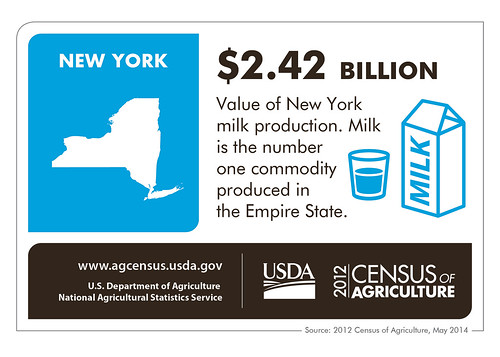
The Census of Agriculture is the most complete account of U.S. farms and ranches and the people who operate them. Every Thursday USDA’s National Agricultural Statistics Service will highlight new Census data and the power of the information to shape the future of American agriculture.
According to the 2012 Census of Agriculture, the value of New York’s number one commodity is nearly half the value of all our agricultural products. The value of milk sales, at $2.42 billion, ranks third among all states. This milk is used in the production of many dairy products, with New York ranking number one among states in the production of yogurt, cottage cheese, and sour cream and also ranking high in the production of cheese.
However, because of New York’s varied geography and large size, New York is agriculturally diverse, with many commodities ranking in the top ten nationally. For example, 2,598 New York farms produce fruit on 93,304 acres. New York traditionally ranks second in the nation in apple production with apples grown on 47,148 acres. New York also produces 39,216 acres of grapes, mostly along the moderating climates on the shores of the Great Lakes, Finger Lakes, and Long Island. New York grows grapes both for juice and for wine, and typically ranks third in total grape production.
New Yorkers love their vegetables with many vegetable crops ranking in the top ten nationwide. New York is the number one cabbage producer with 323 growers producing 11,320 acres of cabbage. Total vegetable acreage amounted to 135,997, of which 57,854 acres were for processing vegetables and 78,143 acres for fresh vegetables. Other vegetables normally ranking in the top ten in the nation are cauliflower, onions, pumpkins, snap beans, squash, sweet corn, and tomatoes.
New York’s soybean acreage increased 55 percent from 199,775 acres in 2007 to 310,104 acres in 2012. New York also grows a lot of corn silage to support the dairy industry, with 496,885 acres grown in 2012, ranking third. New York had 1.85 million acres of land in all forage, including hay, haylage, silage, and greenchop.
The average age of the principal farm operator continues to climb, now at 57.1 years, up from 56.2 years in 2007. The good news is that the number of farm operators under 35 years old increased 14 percent to 2,149. Of New York’s 35,537 primary farm operators, 18 percent are female.
New York is also big in organic farming with 824 certified organic operations, the third highest in the country. Those farms had $97.2 million in organic product sales. Because New York also has one of the biggest cities in the world and is in close proximity to other large metropolitan areas, 2,533 farms sell products directly to retail outlets, the third most in the U.S. We have 578 farms marketing products through community supported agriculture (CSA) arrangements, the fourth most in the nation.
New York is so diverse, we also rank high in many other commodities, including maple production, floriculture, and Christmas tree production.
These are just a few examples of the diversity and size of New York agriculture to be found in the Census of Agriculture.
